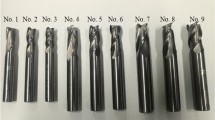Abstract
This case study outlines the use of Taguchi parameter design to optimize the roundness of holes made by an aging plasma-cutting machine. An L9 array is used in a Taguchi experiment design consisting of four controllable factors, each with three levels. With two non-controllable factors included in the setting, we conduct 36 experiments, compared to the 81 parameter combinations (four factors, three levels or 34) required in a traditional DOE setting. Therefore, using the Taguchi method significantly reduces the time and costs of a quality improvement process. Conducted for two response variables—bevel magnitude and the smallest diameter deviation of the hole—the Taguchi experiments gave the optimal combination A1B2C1D3 (small for tip size, 93 in/min for feed rate, 100 V for voltage, and 63A for amperage), which is verified with a confirmation run of 30 work pieces. All 30 cuts meet the quality requirement for subsequent assembly. Furthermore, statistical analysis indicates that the mean value and standard deviation of the confirmation run data are smaller than those before Taguchi parameter design is conducted.
Similar content being viewed by others
References
Fowlkes WY, Clyde CM (1995) Engineering methods for robust product design using Taguchi methods in technology and product development. Addison-Wesley, Reading
Ghani JA, Choudhury IA, Hassan HH (2004) Application of Taguchi method in the optimization of end milling parameters. J Mater Process Technol 145(1):84–92 Jan 1
Zhang JZ, Chen JC, Kirby ED (2007) Surface roughness optimization in an end-milling operation using the Taguchi design method. J Mater Process Technol 184(1–3):233–239 Apr 12
Davim JP, Reis P (2005) Damage and dimensional precision on milling carbon fiber-reinforced plastics using design experiments. J Mater Process Technol 160(2):160–167 Mar 20
Kirby ED, Zhang Z, Chen JC, Chen J (2006) Optimizing surface finish in a turning operation using the Taguchi parameter design method. Int J Adv Manuf Technol 30(11–12):1021–1029 October
Palanikumar K, Karthikeyan R (2006) Optimal machining conditions for turning of particulate metal matrix composites using Taguchi and response surface methodologies. Mach Sci Technol 10(4):417–433 Dec 1
Deng C-S, Chin J-H (2005) Hole roundness in deep-hole drilling as analysed by Taguchi methods. Int J Adv Manuf Technol 25(5–6):420–426 March
Tsao CC (2007) Taguchi analysis of drilling quality associated with core drill in drilling of composite material. Int J Adv Manuf Technol 32(9–10):877–884 April
Bagci E, Ozcelik B (2006) Analysis of temperature changes on the twist drill under different drilling conditions based on Taguchi method during dry drilling of Al 7075-T651. Int J Adv Manuf Technol 29(7–8):629–636 July
Tsao CC, Hocheng H (2004) Taguchi analysis of delamination associated with various drill bits in drilling of composite material. Int J Mach Tools Manuf 44(10):1085–1090 August
Author information
Authors and Affiliations
Corresponding author
Rights and permissions
About this article
Cite this article
Chen, J.C., Li, Y. & Cox, R.A. Taguchi-based Six Sigma approach to optimize plasma cutting process: an industrial case study. Int J Adv Manuf Technol 41, 760–769 (2009). https://doi.org/10.1007/s00170-008-1526-1
Received:
Accepted:
Published:
Issue Date:
DOI: https://doi.org/10.1007/s00170-008-1526-1



